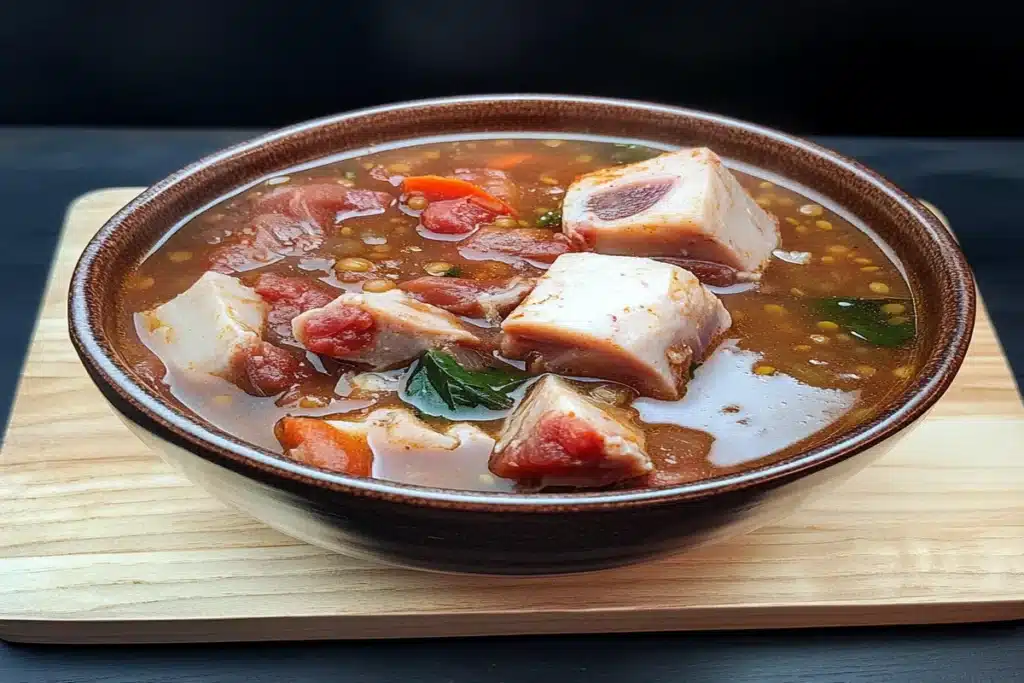Do you ever feel like you’re missing out on the secret to making a dish that’s both comforting and deeply satisfying? A soup bone is your ticket to creating meals that feel like a warm hug in a bowl. Picture this: a simmering pot filling your kitchen with irresistible aromas, promising a dish that’s not just delicious but also packed with wholesome goodness. It’s simple, hearty, and easy to prepare—perfect for cozy family dinners or meal prepping for the week ahead.
But wait, it gets even better! With its rich flavor and versatility, using a soup bone transforms even basic ingredients into something extraordinary. You can create everything from nourishing broths to flavorful stews, and the possibilities don’t end there. Ready to unlock the magic of this culinary gem? Keep reading to discover how to elevate your cooking game while keeping things effortless and enjoyable!
Table of Contents
Exploring the Basics of Soup Bone Cooking
Understanding the Role of Soup Bones in Flavorful Broths
A soup bone is the secret to creating broths that are rich, hearty, and full of flavor. When simmered, the marrow and collagen in the bone release natural flavors and nutrients that elevate any dish. First, the slow cooking process extracts all the goodness, creating a base that tastes like it’s been prepared by a pro. Next, the broth becomes a versatile ingredient for soups, stews, and sauces. It’s an easy way to add depth to your cooking without needing fancy ingredients. Also, soup bones are a great way to use simple, everyday items to make something extraordinary. You’re going to love how easy it is to transform your meals with this technique!
Benefits of Soup Bones in Broths:
- Adds depth of flavor
- Boosts nutritional value (collagen, minerals)
- Simple and affordable to prepare
Choosing the Right Type of Soup Bones for Your Needs
Picking the right soup bone ensures the best results. Some bones are better for thick, gelatinous broths, while others are ideal for lighter, clearer bases. For example:
| Type of Bone | Best Use | Flavor Profile |
|---|---|---|
| Marrow Bones | Rich, creamy broths | Full-bodied, luxurious |
| Joint Bones | High collagen extraction | Thick, gel-like consistency |
| Knuckle Bones | Clear, light soups | Mild, delicate flavor |
Next, consider mixing bones for a balance of flavor and texture. For instance, combine marrow and joint bones to enjoy the best of both worlds. Also, look for bones from reputable sources to ensure quality and freshness.
Creative Uses for Soup Bones Beyond Traditional Broth
Making Hearty Stews and Soups with Soup Bones
Soup bones are a game-changer for creating stews and soups that are filling and flavorful. First, start by preparing your broth with the soup bone as the base. Then, add fresh vegetables like carrots, celery, and onions for a classic combination. Also, throw in some grains or legumes, like rice or lentils, to make the dish even heartier. The result? A comforting meal that warms you from the inside out. It’s perfect for cold nights or when you need a quick pick-me-up.
Quick Tips for Customizing Your Stews:
- Use seasonal vegetables for variety.
- Add herbs like thyme or parsley for extra flavor.
- Include proteins such as chicken or beans for a balanced meal.
Crafting Unique Sauces and Gravies with Bone Stock
Bone stock is not just for soups—it makes excellent sauces and gravies, too. First, reduce the stock to concentrate the flavor. Then, use it as a base for classic gravies or pasta sauces. It’s like giving your dishes a gourmet upgrade without extra effort.
Ideas for Using Bone Stock:
- Stir into creamy pasta sauces for richness.
- Use as a base for homemade gravy.
- Mix into mashed potatoes for added depth.
Why Use Bone Stock for Sauces:
- Enhances flavor naturally.
- Provides a smooth, velvety texture.
- Adds nutritional benefits to everyday meals.
Tips for Maximizing Nutrition and Flavor from Soup Bones
Techniques to Extract Maximum Collagen and Minerals
To get the most out of your soup bones, the key is in the preparation. First, roast the bones for extra flavor. Then, simmer them on low heat for several hours—patience is the secret! Also, adding a splash of vinegar helps release minerals like calcium. Don’t forget to skim off any impurities for a clear, clean broth.
Pro Tips for Maximum Extraction:
- Use a slow cooker for even heat distribution.
- Add aromatic vegetables and herbs.
- Strain the broth through a fine sieve for a smooth finish.
Storing and Reusing Soup Bones Effectively
Soup bones are reusable, making them a budget-friendly option. After making your first batch, store the bones in the freezer for future use. Then, you can simmer them again to extract any remaining goodness.
Storing Soup Bones:
- Keep in airtight bags or containers.
- Label with the date for easy tracking.
- Use within three months for best results.
Reuse Tips:
- Combine with fresh bones for added flavor.
- Add new herbs and vegetables for variety.
- Simmer longer for a second extraction.
Regional and Cultural Twists with Soup Bone Recipes
Exploring Global Variations in Soup Bone Cooking
Soup bones play a starring role in many global cuisines. First, think of the robust flavors of French consommé or Vietnamese pho. Next, consider the heartiness of Italian brodo or Middle Eastern shorba. Each region adds its unique twist, making soup bones a universal favorite.
Popular Global Soup Bone Dishes:
- Pho (Vietnam): Fragrant broth with rice noodles.
- Consommé (France): Clear and refined.
- Brodo (Italy): Rich, warming soup with tortellini.
Incorporating Local Ingredients for Regional Flair
Soup bones are like a blank canvas—you can customize them with local ingredients. Add spices, herbs, or vegetables from your area to create a dish that’s uniquely yours.
Ideas for Local Twists:
- Use seasonal produce for freshness.
- Add regional spices for bold flavors.
- Include grains or legumes native to your area.
Sustainable and Budget-Friendly Cooking with Soup Bones
Reducing Kitchen Waste Through Soup Bone Utilization
Soup bones are a great way to reduce waste. Instead of discarding bones, you can use them to create delicious broths and stocks. This sustainable practice not only minimizes waste but also maximizes value.
How to Use Soup Bones Efficiently:
- Save bones from cooked dishes.
- Use vegetable scraps for added flavor.
- Compost any remaining material after cooking.
Affordable Meal Planning with Soup Bones
Cooking with soup bones is kind to your wallet. They are inexpensive but deliver big on flavor and nutrition. Incorporate them into your meal plan to create filling dishes on a budget.
Budget-Friendly Ideas:
- Prepare large batches of broth for meal prep.
- Freeze portions for future use.
- Combine with affordable staples like rice or beans.
Now that you’ve got the scoop on soup bones, let’s turn all that flavor-packed goodness into a hearty, wholesome dish—time to dive into the Hearty Bone Broth Lentil Soup recipe!
Ingredients
Get ready to gather some simple, wholesome ingredients that make this Hearty Bone Broth Lentil Soup unforgettable. Each ingredient brings its unique charm, creating a dish that’s cozy and flavorful:
- 2 cups Red Lentils – These are the stars of the show, adding heartiness and a creamy texture. Plus, they’re packed with protein!
- 8 cups Bone Broth – The real secret here is using a soup bone to create a rich, flavorful broth that’s soothing and nutrient-dense.
- 2 cups Water – It helps balance the flavors and ensures the broth’s consistency is just right.
- 1 Onion, diced – This adds a sweet and savory base, making every bite deliciously aromatic.
- 4 Large Carrots, chopped – A splash of color and a touch of natural sweetness to complement the lentils.
- 4 Medium Red Potatoes, chopped – These soak up the broth’s flavors, adding a satisfying bite.
- 4 Celery Stalks, chopped – Crisp and aromatic, celery rounds out the vegetable medley perfectly.
- 1 cup Sauerkraut – A tangy twist that brings depth and balances the richness.
- 1 Head of Garlic, minced – Its bold, robust flavor takes the soup to the next level.
- 1 Head of Rainbow Chard, de-stemmed – Packed with vitamins, it adds vibrant color and nutrition.
- 1 32 oz. Can Crushed Tomatoes – A classic addition that enriches the soup with a hearty, slightly tangy taste.
- Salt and Pepper – Essential for seasoning to your liking!
Optional Garnishes:
- Sharp Cheddar Cheese – For a creamy, tangy topping.
- Crunchy Croutons – Add a delightful crunch with homemade or store-bought options.
Step-by-Step Instructions

Follow these fun, easy steps to bring your soup to life!
- Prepare the Lentils – Soak and rinse the lentils the day before. This reduces cooking time and enhances their texture.
- Combine the Base Ingredients – Add the lentils, bone broth, and water to a large stockpot. Bring the mixture to a gentle boil.
- Chop the Vegetables – While the soup heats, chop the onion, carrots, potatoes, celery, and chard. This multitasking saves time!
- Add Veggies to the Pot – Carefully add the vegetables to the pot. Stir to mix everything evenly.
- Simmer and Stir – Let the soup simmer uncovered for 1–2 hours, stirring occasionally. The soup will thicken beautifully.
- Finish with Garlic and Tomatoes – Add the minced garlic and crushed tomatoes. Stir well and season with salt and pepper to taste.
Serving
This recipe makes enough for six hearty servings, perfect for a family dinner or meal prep!
- How to Serve – Ladle the soup into bowls and serve it hot. It’s fantastic on its own or paired with crusty bread.
- Optional Garnishes – Top with shredded cheddar or crunchy croutons for added flavor and texture.
- For a Fun Twist – Swap cheddar for Parmesan or use kale instead of chard for variety.
Tips and Hacks
Make this recipe even easier and more flavorful with these helpful tips:
- Flavor Boost – Add a bay leaf or sprig of thyme while simmering for extra aroma.
- Texture Trick – Blend a portion of the soup for a creamier consistency while keeping some chunks intact.
- Versatile Variations – Swap potatoes for sweet potatoes or add chickpeas for extra protein.
- Storage Tip – Store leftovers in an airtight container for up to 4 days or freeze for later.
Nutrition Facts
- Serving size: 1 bowl (approximately 2 cups)
- Calories: 260
- Fat: 4g
- Carbs: 38g
- Protein: 14g
- Sodium: 620mg
- Fiber: 8g
Note: Values may vary based on ingredient brands and portion sizes.
Prep Time
- Prep time: 20 minutes
- Cook time: 1–2 hours
- Total time: 1 hour 20 minutes–2 hours 20 minutes
Note: Times are approximate and depend on preparation methods.
What to Serve with Hearty Bone Broth Lentil Soup
- Custardy French Dessert NYT : Suggests a dessert pairing to complement the meal.
- Sandwiches : A sandwich pairing suggestion could also work well with lentil soup.
- Crack Green Beans recipe : A potential side dish to serve with the soup.

Frequently Asked Questions (FAQs)
What do you use a soup bone for?
A soup bone is great for making flavorful broth. When you simmer it for hours, it releases nutrients and rich flavors. You can also use the meat on the bone for stews or soups. First, toss it in the pot with some veggies, water, and seasoning. Then, let it cook low and slow. You’re going to love how tasty the result is!
How long should bones be boiled for soup?
Bones should be boiled for at least 2 to 3 hours to make a delicious broth. First, bring the water to a boil, then lower the heat. Simmer gently for the best flavors. You can boil them longer, up to 12 hours if you want a super rich broth. It’s like a slow cooking challenge but totally worth the wait for that deep flavor!
Is the meat on soup bones good to eat?
Yes! The meat on soup bones is totally good to eat. After simmering, it becomes tender and flavorful. First, remove the bone and pull off the meat. It’s perfect for adding into your soup or stew. Also, it’s a great protein boost. You can even use the meat for sandwiches or tacos. It’s delicious and easy to enjoy!
Is bone soup good for you?
Bone soup is packed with nutrients like collagen, calcium, and magnesium. These are great for your joints and skin. First, the bones release all these healthy elements when they simmer. Next, it’s a fantastic way to support your bones and overall health. It’s like a fun little health boost in every spoonful! You’re going to feel so good after sipping it.
Why do I feel weird after drinking bone broth?
If you feel weird after drinking bone broth, it could be due to detoxing. Bone broth is rich in amino acids and minerals, which can stir things up in your body. First, try drinking smaller amounts. Then, stay hydrated and give your body time to adjust. It’s like your body getting a little reset, so don’t worry! Just take it slow and enjoy!
Conclusion
Soup bones are an incredibly versatile ingredient that can elevate your cooking in so many ways. First, they’re perfect for making rich, flavorful broths. The nutrients they release help nourish your body, and they’re full of delicious possibilities.
You can use soup bones for more than just broth. The meat on the bones is tender and full of flavor, making it great for stews or sandwiches. Next, you can experiment with different seasonings, herbs, and veggies to make your soup unique every time. It’s like having a blank canvas! In addition, the benefits of bone broth, such as supporting joint health and providing essential minerals, make it a nourishing treat. You’re going to love how easy it is to prepare and how tasty it turns out.
So grab some soup bones and start experimenting—you’ll be amazed by the results! Enjoy the process and have fun with it!

